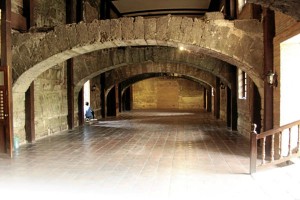Exhibition partners are the Heritage Conservation Society; Security Bank Foundation; Our Lady of Lourdes Hospital; Ayala Malls; Lopez Memorial Museum; and Estudio Loyzaga SA de CV of Mexico City.
Now, to answer the inevitable question: What is the Escuela Taller?
At Escuela Taller de Intramuros, young men and women, mostly out-of-school youths or trainees sent by heritage-rich provincial local governments, learn classical carpentry, traditional construction technology, and modern trades like plumbing and electrical installation.
Conservation of heritage structures requires knowledge of the original skills in which these structures were built.
Therefore, the goal of Escuela Taller is to provide skilled manpower needed for conservation of manmade Philippine heritage sites. It also provides out-of-school youths with skills that lead to future employment.
Old Recoletos site
Tucked away in the reaches of Revelin de Recoletos next to the Intramuros walls is Escuela Taller, founded three years ago, a collaboration among Agencia Española de Cooperación Internacionál para el Desarrollo; National Commission for Culture and the Arts (NCCA); Intramuros Administration (IA); Technical Education and Skills Development Authority (Tesda); and the Department of Social Welfare and Development (DSWD).

A success in Spain, Escuela Taller was replicated by the government in 40 cities in 17 countries in Central and South America. Manila is the only Escuela Taller in Asia.
Among the first 75 apprentices for the 1½-year training course were men and women age 16-25, all from Baseco Compound in Port Area, Manila, selected through a screening process conducted by the DSWD.
Free rides to and from school and free meals were provided to the out-of-school youths.
Once accepted into the program, which is provided free of charge, students learn 18th- and 19th-century construction techniques: carpentry, masonry; stone, brick, wood carving; metalwork (including decorative grills). The modern components added to the curriculum are electrical and plumbing technologies.
Instructors at Escuela Taller are trained Filipino conservation practitioners who are professionally active in the field.
Foreign experts
Foreign experts have joined the faculty. Mario Buendia from Mexico teaches stone masonry and sculpture. David Mason, graduate of University of Leicester in the UK, teaches stone masonry.
Part of the school curriculum is the Spanish language, necessary for conservation work in the Philippines since much of the heritage was built during the Spanish colonial period, when terminology, archival plans and diagrams were written in Spanish.
Training is not all technical at Escuela Taller. Students attend classes in Mathematics, English, Values Education, and learn basic entrepreneurial skills.
Michael Manalo, director of Escuela Taller, believes the skills students learn can help in their future.
If graduates of Escuela Taller were commissioned to work on a nonrestoration project, he believes it is likely their pay scale would equal that of ordinary carpenters, masons or metalworkers.
However, their training hones their skills so that less manpower is required. Their training in time management means projects are completed with more efficiency and less time.
First provincial project
Escuela Taller sees its graduates as eventually becoming leaders in the workforce.
The first group of Escuela Taller graduates now implement conservation projects for IA.
Students are restoring the Almacenes Reales (Royal Storehouse) building just inside the Fort Santiago gate, which was severely damaged during World War II. It will reopen as the Intramuros Visitor Center.
Much work awaits Escuela Taller graduates. Spanish-colonial heritage structures all over the Philippines await conservation rather than the wanton destruction that is happening.
Escuela Taller has branched out of Intramuros. Its first provincial project will be in Talisay, Negros Occidental, where they will train locals on masonry conservation, which is to be done as a conservation measure on two of the most elegant ancestral houses in the region.
One of the little-known heritage resources existing in the Philippines, Escuela Taller deserves all the support the Filipino nation can give. The best support would be to hire its graduates for projects.
Escuela Taller contacts: etintramuros@gmail.com or https://etintramuros.
wordpress.com/
Feedback is invited at pride.place@gmail.com